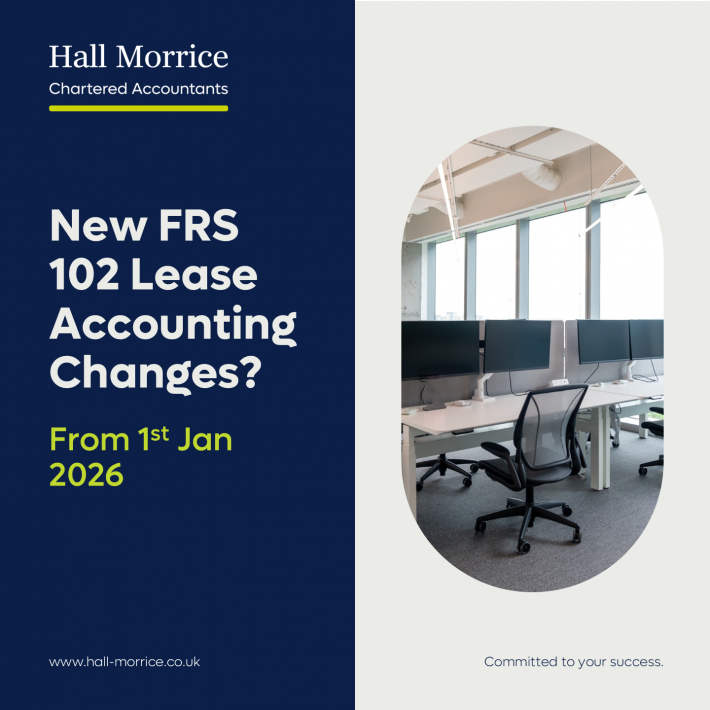
In our previous article, What You Need to Know About the Major FRS 102 Changes, we introduced the upcoming amendments to FRS 102, which take effect from 1 January 2026, bringing significant changes across multiple areas of financial reporting. One of the most substantial changes relates to lease accounting, aligning more closely with IFRS 16.
These changes represent one of the most significant updates to FRS 102 in recent years and Hall Morrice is ready to support businesses through every step of the transition. Whether you are a growing SME or a larger organisation, our experienced team can guide you through impact assessments, system changes and strategic planning. These changes matter to finance teams, business owners, lenders and investors, with potential effects on borrowing, financial reporting and tax. Early preparation with expert advice can help you avoid misstatements and stay ahead of compliance risks.
Under the revised FRS 102 framework, lessees will be required to recognise most leases as both an asset and a liability. This change will fundamentally alter how lease obligations are recorded and presented in financial statements.
Our team can help you identify which leases will be affected and calculate the right-of-use (ROU) asset and lease liability correctly, providing tailored advice for your business structure.
Calculating lease liabilities under the revised FRS 102 framework involves several complexities. Businesses must determine both the lease liability and the discount rate, each of which presents unique challenges. Accurately assessing these components is crucial to avoiding misstated financial statements.
Hall Morrice can support you by reviewing your lease portfolio, advising on assumptions, and helping you apply appropriate methodologies.
Determining the appropriate discount rate is a critical step in calculating the present value of the lease payments, as it directly affects the lease liability and ROU asset measurements. There are three primary methods to determine the discount rate:
Our team can support your business in selecting and documenting a suitable discount rate, helping reduce the risk of audit challenge or regulatory scrutiny.
Lessees must carefully justify and document their chosen discount rate methodology to ensure compliance and financial accuracy. Incorrect estimations may lead to misstated liabilities and financial position distortions. Consulting external advisors or benchmarking against market rates may be necessary to ensure compliance and accuracy.
The new approach to lease accounting will significantly impact key financial metrics, with the following expected changes:
Balance Sheet:
Profit & Loss Account:
Let’s bring this to life with a simple example. Imagine your business enters into a five-year property lease on 1 January 2026, at £400,000 per year, paid quarterly in advance.
Under the current FRS 102 standard:
The lease is treated as an operating lease, and the full £400,000 annual payment is charged directly to the Profit and Loss Account each year:
|
Year Ended 31 December |
2026 |
2027 |
2028 |
2029 |
2030 |
|
Rental lease expense |
£400,000 |
£400,000 |
£400,000 |
£400,000 |
£400,000 |
Under the amended FRS 102 standard:
The lease is brought onto the balance sheet as a Right of Use (ROU) asset and a lease liability. For this example, assume a discount rate of 8%.
Profit & Loss Account:
|
2026 |
2027 |
2028 |
2029 |
2030 |
|
|
|
|
|
|
|
|
|
Depreciation |
£335,260 |
£335,260 |
£335,260 |
£335,260 |
£335,260 |
|
Lease finance cost |
£114,219 |
£91,357 |
£66,889 |
£40,017 |
£11,218 |
|
Total charge |
£449,479 |
£426,617 |
£402,149 |
£375,277 |
£346,478 |
Balance Sheet:
|
1 Jan 2026 |
2026 |
2027 |
2028 |
2029 |
2030 |
|
|
ROU asset |
£1,676,300 |
£1,341,040 |
£1,005,780 |
£670,520 |
£335,260 |
- |
|
Lease liability |
(£1,676,300) |
(£1,390,519) |
(£1,081,876) |
(£748,765) |
(£388,782) |
- |
At the start of the lease, the full ROU asset and lease liability of £1,676,300 are recorded on the balance sheet.
Instead of a straight-line lease expense, the new model separates the cost into depreciation and finance charges. This results in higher charges to the Profit & Loss in the earlier years, due to the front-loaded nature of the finance cost. The finance cost gradually decreases as the lease liability is paid down over time.
1. Impact on Key Performance Indicators (KPIs)
Businesses relying on EBITDA as a performance metric may see an artificial improvement due to the removal of lease costs from operating expenses. Comparatively, with interest costs higher earlier in the lease, net profit will be adversely affected early in leases.
2. Banking and Financial Covenants
Changes in reported debt levels and interest costs may affect compliance with banking covenants. Early engagement with lenders is advisable to discuss potential adjustments to covenant calculations.
3. Company Size Thresholds
In conjunction with company size thresholds increasing in 2025, businesses should assess whether lease capitalisation might push them into a higher reporting category, leading to additional compliance obligations.
4. Financial Systems and Internal Controls
Companies will need to ensure their financial reporting systems can accommodate the new lease accounting requirements. This may involve system upgrades or modifications to capture lease data accurately.
5. Tax Considerations
Changes in lease accounting could impact taxable profits and deferred tax calculations. Our tax specialists can help you assess how these changes affect your tax position and guide your planning strategy.
The implementation date of 1 January 2026 may seem distant, but businesses should take action now to ensure a smooth transition. Steps to take include:
Navigating the changes in FRS 102 lease accounting requires careful planning and expert guidance. Our team is ready to support your business with:
If you’d like to discuss how these changes will affect your business, please reach out to Paul Archibald (p.archibald@hall-morrice.co.uk).